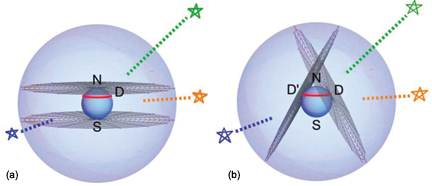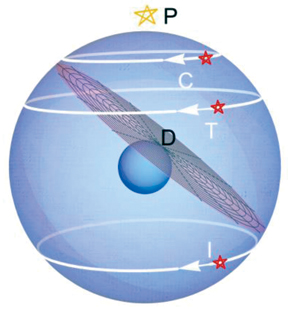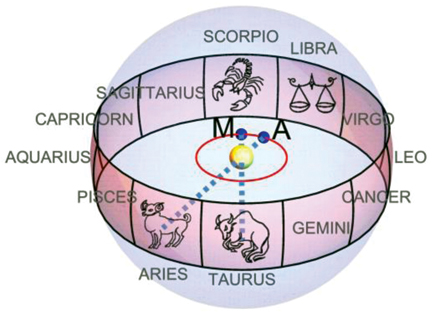Rajaram Nityananda
Ask any student how the sun moves in the sky and you will get the standard answer: it rises in the east, is overhead at noon, and sets in the west. This is more or less true, but a student observing the phenomenon keenly over a year will be able to notice more details. The sun does not rise at the same place on the horizon every day. This point moves southwards (Dakshinayana, meaning ‘southern journey’) from late June to late December and then moves northwards (Uttarayana) from late December to late June of the next year. This shift in the rising point of the sun on the horizon over the year is not small – 47° or more! Such simple observations are a good opportunity for teachers to introduce more concepts relating to the Earth’s rotation around its axis, as well as the movement of the Earth in its orbit around the sun. This is information that you will easily find in a textbook, but it is difficult to understand such concepts purely from diagrams in the two dimensions of a book. This article has suggestions for activities that teachers can use to help students develop an understanding of what they can see in the sky.

It is very useful to think of the sky as a very large globe or sphere with the Earth on the inside, at its centre. At any given time, we see only that half of the sky that is above the horizon. Figure 1a shows that someone on the opposite side of the Earth will see the other half. Our ancestors thought of all the objects – stars, planets, sun, moon – as attached to this sphere. Today, we know that they are at different distances from us. The sphere is just a convenient way of keeping track of the different directions of these objects.
The first step is to appreciate that the apparent movement of the sun and the stars in the sky can be explained by the movement of the Earth. A famous verse by Aryabhata says this very well. In translation, it reads*: “Just as a passenger in a boat moving downstream sees the stationary (trees on the river banks) as traversing upstream, just so does an observer in Lanka see the fixed stars as moving towards the west at exactly the same speed (at which the Earth moves from west to east).”
Note that he is imagining an observer at the North Pole (which he calls Lanka). This is sketched in Figure 2a, a view of someone outside the Earth, who sees it rotating about its axis. Figure 2b shows the situation form the point of view of someone on Earth, who thinks the sky is rotating in the opposite direction. The idea that Aryabhata is explaining can be demonstrated by a simple activity, for which a large umbrella can be used. This can be held directly over the student’s head and rotated or the umbrella can be fixed in one place and the student asked to turn. In both cases, the spokes on the umbrella will appear to move. (Figure 2c)

(b) The observer imagines she is fixed and so sees the stars rotate in the opposite direction.
(c) This can be illustrated using an umbrella held by one student. Another student can stand below, and turn anticlockwise, as in (a), or the umbrella can turn clockwise, as in (b). In both cases, the spokes of the umbrella appear to rotate clockwise about the handle (the axis of rotation).
Not just the sun, but the stars, moon, planets all appear to rise and set. It is simpler to explain this by the rotation of the Earth around its axis, pointing to the pole star, rather than say that all these different objects move around the Earth.

As viewed from the North Pole, the stars do not rise or set – they move in horizontal circles (Figure 2b). To understand rising and setting, one has to imagine an observer who is not at the North Pole, but say in Delhi (Figure 3). This can be demonstrated by tilting the umbrella so that its handle is no longer vertical. Then one sees the apparent motion of the stars in circles around the pole star. Stars very close to the pole star will be seen at all times of the night, but many of them will rise and set (see Figure 3). This is because the circle in which the stars appear to move intersect the horizon. Some stars close to the south pole of the celestial sphere cannot be seen at all by our northern hemisphere observer, as indicated in the figure.
Unfortunately, in Delhi, and perhaps most cities, it is difficult to see the pole star, even in clear weather, because of atmospheric pollution and bright lights, however, one can still go to a nearby open place that has a clear view of the night sky and little or no artificial light and observe these movements directly. The figure, the demonstration by the umbrella, and the actual observation together will help establish the apparent movement of the stars in the student’s mind. Another option, available in big cities, is to go to a planetarium where all these are demonstrated from different points on Earth. There is also a freely available software, known as Stellarium, which shows the positions of the stars in the sky at any time as seen from any place on Earth. It is downloadable from http://stellarium.org/; one can also run a version on a browser without downloading it, at stellarium-web.org.
Using any of these methods, but preferably starting with direct observation, a simple, fun and instructive activity for younger students is to identify the constellations – Leo/Simha, the lion, or Libra/Tula, the balance, or Scorpio/Vrischika the scorpion#. I have picked three examples where the pattern we see in the sky is not difficult to relate to its name.
If the class is fortunate enough to live in an area with clear skies and not much light pollution, they can make another observation. About half an hour after the sun sets, stars become visible, even in the western sky. They can note the stars that set in the west soon after the sun, and also the stars that are rising in the east at the same time. As an example, towards the end of April, one will see the constellation Taurus/Vrishabha with its characteristic V shape, (the head of the bull) low in the western sky, while Gemini/Mithuna, (the twins) with two prominent stars, is higher, and follows Taurus moving downwards towards the western horizon. On the opposite horizon, one will be able to see Virgo/Kanya rising and sometime later Libra/Tula. We cannot see in which constellation the sun is present because the stars are not visible during daytime. However, if one comes back a month later, towards the end of May, one can infer that the sun has moved with respect to the stars. Gemini will now be low in the western sky, while on the opposite horizon, Virgo will be high in the eastern sky and Libra/Tula will have just risen. It appears that the sun has moved eastward, from one constellation to the next in a month’s time. This pattern is repeated month after month – of course, in most of India, monsoon will intervene and make observation difficult until October. In one year, the sun will be back to where it was in April.

Since we keep time by the sun, we can see that a given star, or constellation will rise two hours earlier every month. One should follow up these observations with an explanation, given in Figure 4. It would help if there is an actual demonstration. This is best carried out in a large open space, preferably the games field. One can have students acting out different roles. We can have 12 students standing in a circle at a distance of say five metre radius from the student who is the sun at the centre. We need one more student who plays the Earth, and a smaller circle, say of one metre radius, representing the path of the Earth around the sun.
The student who is the Earth can turn around his own axis, but not move around the sun. What that student will then see is rising and setting of the sun and stars, but both will have the same period (24 hours). Also, the sun will be seen against the background of the same group of stars. But this is not what we observe. When we put in the motion of the Earth around the sun, in one month, the person representing the Earth will move in the orbit by one twelfth of the full circumference, about 30°. Now the sun will be seen against another constellation, and another, and another, month after month. These 12 constellations are called the Zodiac – (the individual constellations are called Rashi’s and the Zodiac Rashichakra – circle of constellations). With respect to the sun, the stars will rise earlier and earlier. This model is not to scale. The nearest star is 200000 times further away from us than the sun.
For younger classes, this may be a good practical experience in connecting the words and pictures in their books with what they can actually observe with their own eyes. We conclude by suggesting a few topics for students to go further. The motion and phases of the moon, the apparent movement of the planets as seen from Earth are examples. The inclination of the Earth’s axis to the plane of the Earth’s orbit (the field in the above demonstration) adds another aspect – some of the constellations, from Pisces to Leo, are seen in the northern sky, and the other six, Virgo to Aquarius, are in the southern sky. This can be connected with the seasons, which are part of the geography curriculum. Finally, there is the interesting fact that the Earth’s axis is not fixed – it moves along a cone in 25800 years. This means that the current pole star will not remain the pole star always. It also means that 12900 years from now, the northern and southern parts of the Zodiac will be interchanged!
Note: I thank Geetha Iyer for her critical reading of an earlier version of this article and helpful suggestions. The figures are an important part of this article and I am very grateful to Jayanth and Shruti Vyasanakere, who generated them.
*The details, and the original Sanskrit text, can be found in an article by Amartya Kumar Datta in Resonance, journal of science education Volume 11, Issue 3, March 2006, pp 51-68, available for download at https://www.ias.ac.in/article/fulltext/reso/011/03/0051-0068
#Why is it that the names of the constellations adopted in the western world agree with those used in India? The answer is that both were inspired by Greek astrology (which in turn were influenced by the Babylonians). In fact, one of the earliest texts on astrology in India is called ‘yavanajataka’ (see https://en.wikipedia.org/wiki/Yavanajataka) – Yavana is the Sanskrit term for a Greek person.
The author recently retired from the Azim Premji University, Bengaluru, where he taught the undergraduate programme. Earlier, he had worked at the Raman Research Institute and the Tata Institute of Fundamental Research in areas of optics and astronomy and was editor of Resonance, a journal of science education. He can be reached at rajaram.nityananda@apu.edu.in.
